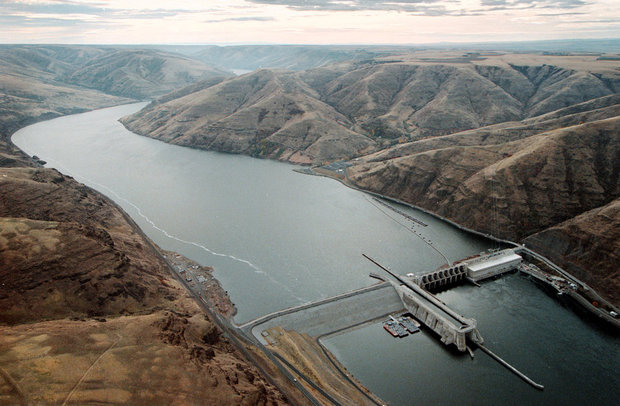forum
library
tutorial
contact

Why is Bad Science Protecting
the Lower Snake River Dams?
by Borg Hendrickson
High Country News, August 12, 2015
|
the film forum library tutorial contact |

|
Why is Bad Science Protecting
by Borg Hendrickson
|
 The U.S. Army Corps of Engineers, the country's dam-building agency, sounded like it knew what it was talking about in 2002. After spending six years and $30 million, the agency confidently recommended not breaching four fish-killing dams on the Lower Snake River.
The U.S. Army Corps of Engineers, the country's dam-building agency, sounded like it knew what it was talking about in 2002. After spending six years and $30 million, the agency confidently recommended not breaching four fish-killing dams on the Lower Snake River.
But now, backed by 15 years of data primarily from the Corps itself, we can say that the Corps was dead wrong. Its claims of being able to help salmon flourish while keeping the dams intact were wildly optimistic. Here's what the agency's Walla Walla District staffers believed was better than breaching:
The result? The hydro-system's 2000-2012 average smolt survival for wild chinook salmon was just 52 percent, and for wild steelhead just 45 percent. Most of the highest survival years coincided with the increased spills mandated by Federal District Judge James Redden. In late 2013, the National Oceanic and Atmospheric Administration's fisheries service concluded: "Chinook survival through the hydropower system has remained relatively stable since 1999, with the exception of lower estimates in 2001 and 2004." So now we know: $700 million essentially did little to boost smolt survival.
Not true; over the past 20 years, the total freight transported on the Lower Snake's reservoirs has declined by 69 percent. Agriculture is one of the few industries that hasn't pretty much abandoned the waterway, and even the region's farmers have begun developing cooperative rail hubs and engaging rail companies in shipping discussions. At 2014's end, container-on-barge (COB) traffic, in particular, had declined by 82 percent, and in April 2015, the waterway's only COB port, the Port of Lewiston, indefinitely suspended all COB shipping. In fact, the Corps' itself identifies the waterway as "of negligible use."
Although the four dams' generating capacity was designed to total 3,033 megawatts, the 2000-2012 average annual output was just 961 megawatts. Wind power, meanwhile, has surged, and in the Pacific Northwest boasts an 8,976 megawatt capacity. In 2012, wind produced 2,007 megawatts -- twice that produced by all four dams.
During the next 15 years, however, all 24 turbines will exceed 45 years, and three at Ice Harbor Dam are already being rehabbed at a contract price of $97 million. Thus, calculated in today's dollars, one 24-turbine rehab would cost about $776 million, and two would cost over $1.5 billion.
Doing so today would be illegal. A 2013 policy, "Federal Principles and Guidelines for Water and Land Related Resources Implementation Studies," now requires the inclusion of passive values. If this policy had been in place in 2002, the Corps would have had to admit that leaving the four dams intact made no sense from an economic perspective.
When Jim Waddell of Port Angeles, Washington, a retired 35-year veteran of the Corps, recently reanalyzed the agency's 2002 study, he found that it had underestimated the cost of retaining the four dams by $160.7 million a year over the project's 100-year life. What's more, he says, internal Corps documents clearly show that the Walla Walla District knew there were false assumptions, errors and omissions in the agency's study. Nonetheless, for reasons of cost and expediency, the Corps chose not to correct those errors.
Waddell's analysis is revelatory and deeply disturbing. Let's hope that it opens the agency's eyes so that staffers weigh the true costs and potential waste of keeping these four dams in place. Let's hope, too, that it opens the eyes of national leaders evaluating infrastructural wastes versus needs. It is long past time for the river to run free.
learn more on topics covered in the film
see the video
read the script
learn the songs
discussion forum
